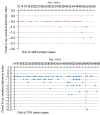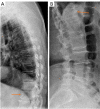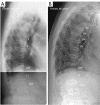A summary of our recent evidence-based works on radiographic diagnostics of prevalent osteoporotic vertebral fracture in older men and women
- PMID: 36915360
- PMCID: PMC10006108
- DOI: 10.21037/qims-22-1411
A summary of our recent evidence-based works on radiographic diagnostics of prevalent osteoporotic vertebral fracture in older men and women
Conflict of interest statement
Conflicts of Interest: The author has completed the ICMJE uniform disclosure form (available at https://qims.amegroups.com/article/view/10.21037/qims-22-1411/coif). YXJW serves as the Editor-in-Chief of Quantitative Imaging in Medicine and Surgery. He is the founder of Yingran Medicals Co., Ltd., which develops medical image-based diagnostics software including those for vertebral compressive fracture evaluation. The author has no other conflicts of interest to declare.
Figures


























Similar articles
-
Prediction of Incident Major Osteoporotic and Hip Fractures by Trabecular Bone Score (TBS) and Prevalent Radiographic Vertebral Fracture in Older Men.J Bone Miner Res. 2016 Mar;31(3):690-7. doi: 10.1002/jbmr.2713. Epub 2015 Oct 21. J Bone Miner Res. 2016. PMID: 26378772 Free PMC article.
-
Joint Associations of Prevalent Radiographic Vertebral Fracture and Abdominal Aortic Calcification With Incident Hip, Major Osteoporotic, and Clinical Vertebral Fractures.J Bone Miner Res. 2021 May;36(5):892-900. doi: 10.1002/jbmr.4257. Epub 2021 Mar 17. J Bone Miner Res. 2021. PMID: 33729640 Free PMC article.
-
Lumbar disc degeneration in osteoporotic men: prevalence and assessment of the relation with presence of vertebral fracture.J Rheumatol. 2013 Jul;40(7):1183-90. doi: 10.3899/jrheum.120769. Epub 2013 Jun 1. J Rheumatol. 2013. PMID: 23729808
-
Radiographic osteoporotic vertebral fractures in elderly men: a brief review focusing on differences between the sexes.Quant Imaging Med Surg. 2020 Sep;10(9):1863-1876. doi: 10.21037/qims-2020-21. Quant Imaging Med Surg. 2020. PMID: 32879863 Free PMC article. Review.
-
Identifying osteoporotic vertebral endplate and cortex fractures.Quant Imaging Med Surg. 2017 Oct;7(5):555-591. doi: 10.21037/qims.2017.10.05. Quant Imaging Med Surg. 2017. PMID: 29184768 Free PMC article. Review.
Cited by
-
Endplatitis short vertebrae.Quant Imaging Med Surg. 2024 Mar 15;14(3):2725-2733. doi: 10.21037/qims-24-20. Epub 2024 Feb 4. Quant Imaging Med Surg. 2024. PMID: 38545052 Free PMC article. No abstract available.
-
Conversion of osteoporotic-like vertebral fracture severity score to osteoporosis T-score equivalent status: A framework study for older Chinese men.Osteoporos Sarcopenia. 2023 Mar;9(1):14-21. doi: 10.1016/j.afos.2023.03.004. Epub 2023 Mar 24. Osteoporos Sarcopenia. 2023. PMID: 37082356 Free PMC article.
-
Lower osteoporotic-like vertebral fractural deformity (OLVF) prevalence and severity among older Thais and Indonesians than among older Chinese.Quant Imaging Med Surg. 2025 Jan 2;15(1):786-800. doi: 10.21037/qims-24-430. Epub 2024 Dec 2. Quant Imaging Med Surg. 2025. PMID: 39839043 Free PMC article.
-
Revision of the 1994 World Health Organization T-score definition of osteoporosis for use in older East Asian women and men to reconcile it with their lifetime risk of fragility fracture.Skeletal Radiol. 2024 Apr;53(4):609-625. doi: 10.1007/s00256-023-04481-7. Epub 2023 Oct 27. Skeletal Radiol. 2024. PMID: 37889317 Review.
-
Schmorl's node of primarily developmental cause and Schmorl's node of primarily acquired cause: two related yet different entities.Quant Imaging Med Surg. 2023 Jun 1;13(6):4044-4049. doi: 10.21037/qims-23-252. Epub 2023 Apr 12. Quant Imaging Med Surg. 2023. PMID: 37284078 Free PMC article. No abstract available.
References
-
- Wáng YXJ, Diacinti D, Yu W, Cheng XG, Nogueira-Barbosa MH, Che-Nordin N, Guglielmi G, Ruiz Santiago F. Semi-quantitative grading and extended semi-quantitative grading for osteoporotic vertebral deformity: a radiographic image database for education and calibration. Ann Transl Med 2020;8:398. 10.21037/atm.2020.02.23 - DOI - PMC - PubMed
Publication types
LinkOut - more resources
Full Text Sources
